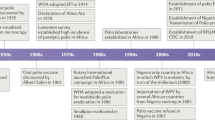Abstract
Indigenous wild polioviruses have been virtually eliminated from the 51 countries of the european Region of the world Health Organization (WHO), an achievement that is of critical importance to the global initiative to eradicate poliomeylitis by the year 2000. An international commission has been established to certify the elimination of poliomyelitis from this region. european countries have recently been requested to establish National Certification Committees to review and submit the necessary documentation and surveillance data. In some Western European countries where polio has not been reported for many years, the challenge will be to produce robust evidence demonstrating both the current absence of wild poliovirus and the means to promptly detect and respond to possible importations of wild poliovirus for the next several years, up to global eradication and the cessation of polio vaccination. Key messages:
1. laboratory-based surveillance with collection of faecal specimens is necessary to demonstrate the absence of indigenous wild poliovirus
2. certification can only occur after all countries have demonstrated the absence of indigenous wild polioviruses for at least 3 years and have the means to detect and respond to importations of wild poliovirus for several years into the future.
3. Any single case of poliomyelitis in europe now requires an immediate public health response which includes virological investigation and prompt notification to the world Health Organization.
Similar content being viewed by others
References
World Health Organization. Global eradication of poliomyelitis by the year 2000. Geneva: World Health Organization, 1988. World Health Assembly Resolution No. WHA41.28.
Expanded Programme on Immunization. Progress towards global eradication of poliomyelitis, 1997. Wkly Epidemiol Rec 1998:73:161-168.
Expanded Programme on Immunization. Poliomyelitis eradication: The WHO Global Laboratory Network. Wkly Epidemiol Rec 1997; 72: 245-249.
Expanded Programme on Immunization. Certification of poliomyelitis eradication-the Americas. Wkly Epidemiol Rec 1994; 69: 293-295.
Expanded Programme on Immunization. Progress towards poliomyelitis eradication, WHO European Region, 1997 May 1998. Wkly Epidemiol Ree 1998; 73: 197-200.
World Health Organization Regional Office for Europe. Report on the First Meeting of the European Regional Commission for the Certification of Poliomyelitis Eradication. Copenhagen: World Health Organization, 1996. WHO Document No. EURIICP/CMDS 03 0113.
Oostovogel PM, van Wijngaarden JK, van der Avoort HGAM, et al. Poliomyelitis outbreak in an unvaccinated community in the Netherlands, 1992-93. Lancet 1994; 344:655-670.
Kew OM, Mulders MN, Lipskaya GJ, da Silva EE, Pallansch MA. Molecular epidemiology of poliovirus. Semin Viro1 1995; 6: 401-407.
Expanded Programme on Immunization. Poliomyelitis outbreak, Bulgaria. Wkly Epidemiol Rec 1992; 67, 336-337.
Expanded Programme on Immunization. Poliomyelitis outbreak, Albania. Wkly Epidemiol Rec 1996; 71: 289-296.
Prevots DR, Ciofi degli Atti ML, Sallabanda A, et al. Outbreak of paralytic poliomyelitis in Albania, 1996; High attach rate among adults and apparent interrup tion of transmission following nationwide mass vaccination. Clin Infect Dis 1998; 26: 419-425.
Expanded Programme on Immunization. Progress towards poliomyelitis eradication, WHO European Region, 1991-September 1997. Wkly Epidemiol Rec 1997; 72: 321-328.
Expanded Programme on Immunization. Progress towards poliomyelitis eradication, WHO Eastern Mediterranean Region. Wkly Epidemiol Rec 1997; 72: 261-266.
World Health Organization. Report of the First Meeting of the Global Commission for the Certification of the Eradication of Poliomyelitis. Geneva: World Health Organization, 1995. WHO Document No. WHO/EPU GEN/95.6.
Hull HF, Ward NA, Hull BP, Milstein JB, de Quadros C. Paralytic poliomyelitis: Seasoned strategies, disappearing disease. Lancet 1994; 343:1331-1337.
Birmingham ME, Linkins RW, Hull BP, Hull HE Poliomyelitis surveillance: The compass for eradication. J Infect Dis 1997; 175 Suppl 1: S146-S150.
Expanded Programme on Immunization. Acute flaccid paralysis (AFP) surveillance: The surveillance strategy for poliomyelitis eradication. Wkly Epidemiol Rec 1998;73:113-117.
Author information
Authors and Affiliations
Rights and permissions
About this article
Cite this article
Smith, J., Aylward, R., Salisbury, D. et al. Certifying the elimination of poliomyelitis from Europe: Advancing towards global eradication. Eur J Epidemiol 14, 769–773 (1998). https://doi.org/10.1023/A:1007530009611
Issue Date:
DOI: https://doi.org/10.1023/A:1007530009611




